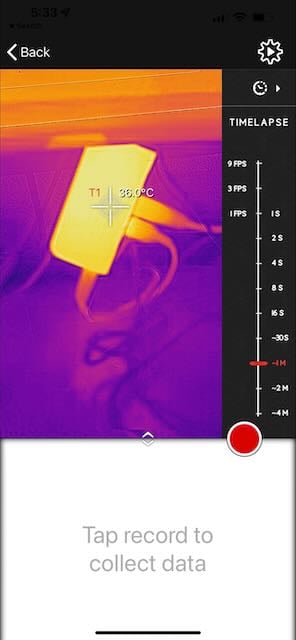Vernier Thermal Analysis Plus is a purpose-built app for time-based data collection from a FLIR ONE camera.
The Vernier Thermal Analysis Plus app is designed for experiments typically running for a few minutes in duration. For this use no particular care needs be taken to prevent problems with battery life or memory. However, if you want to collect data for longer duration experiments, you will need to account for three things: battery life of the camera, battery life of the host device (phone or tablet), and the volume of data storage available on the device.
The camera generates voluminous data as every pixel in every frame contains temperature data which is recorded by the app. As a result it is important to use the time lapse mode for videos lasting more than a few minutes. The time lapse setting allows you to reduce the rate at which frames are recorded. Experiments with slow temperature changes that continue for tens of minutes or more generally do not require multiple measurements each second. Select the slowest frame rate compatible with your experimental needs. For example, you may want to collect a frame only once each minute for an experiment lasting two hours.

In addition to the limits of data storage on the device, you are also limited by the battery life of the camera and the host device. If you connect a charging cable to the FLIR camera, you can run it indefinitely while attached to your device. The host device battery life then becomes the limiting factor in the duration of data collection. A device with a fully charged battery will collect thermal data for two or three hours, or less if the battery is not in new condition.
If the host device is capable of inductive charging (eg, an iPhone with Qi or MagSafe charging) then you can provide power to both the device and the camera, allowing for extended data collection times. We have not tested the limits of data collection with this configuration. Timelapse recording would be essential in this case.
Note that if the host phone or tablet runs out of power, all collected data will be lost. As a result, stop data collection before the battery is exhausted, and save your data.
